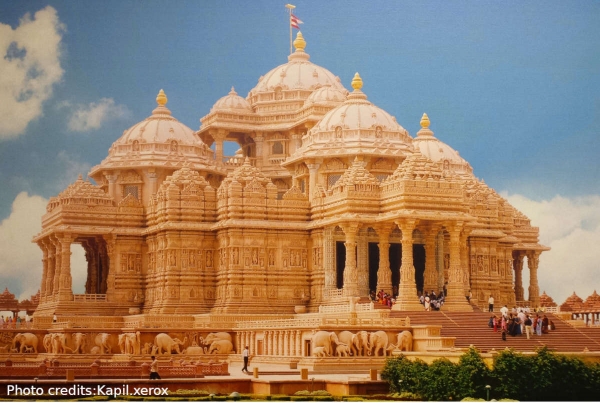The Akshardham Temple in New Delhi, also known as Swaminarayan, is one of the great postal cards of the city. Opened less than two decades ago, this is a treat for the eyes and the largest Hindu temple on the planet and has become one of the top pilgrimage and tourist destinations in New Delhi and India.

Photo Credits: “Akshardham Angled, Wikimedia Commons by Kapil.xerox, CC-BY 4.0
Dedicated to Swaminarayan, a Yogi, a holy man believed to have been a manifestation and embodyment of the divine, the Akshardham Temple symbolizes, as its name implies, the home of the divine, the eternal.
This magnificent religious complex, which helps us to imagine the splendor of ancient times of places with Angkor Wat, is absolutely massive, filled with sublime architectural details. Composed of temples, gardens, portals, animated by shows and exhibitions, it is easy to get lost for hours while exploring its mystical, almost magical environment, a testament to Indian culture and identity. As we did so, we discovered nooks, footprints of the Buddha, and at an unexpected moment, we ended up sitting in a small shrine, the Abishek Mandap, with a holy man reciting mantras, eventually blessing us with the holy water of the Ganga River.
It is worth taking at least an afternoon or a day to visit Akshardham Temple, with the time and calm necessary to explore and enjoy the different areas and many activities available at the religious complex:
- Mandir is the central element of the Akshardham Temple. Built of pink stone and marble, it has over twenty thousand statues representing Hindu figures, nine domes, 237 sublime-worked pillars. The exterior facade is all a huge sculpture, full of symbolism. It is an absolutely extraordinary space that is intended for the house of the divine and the eternal.
- Sahajanand Pradarshan or Hall of Values is an area dedicated to Swaminarayans life. It dislpays, through sound and video, the events that marked the life of the yogi and moral values that they represent.
- The Nilkanth Kalyan Yatra Room also displays a video that portrays the pilgrimage Swaminarayan began at the age of 11.
- Sanskruti Vihar offers a boat trip on a small artificial river. The banks are full of representations of aspects of Indian culture and history.
- Yagnapurush Kund, a huge water tank, is the stage for the light and water show that takes place at night.
- Bharat Upavan or Garden of India is a vast corridor with several statues on its flanks. These represent various figures of Indian culture and history. The problem is that the info plates are not readable.
- Yogi Hraday Kamal is an extraordinary garden with a strange and unique architecture, close to the eating area.
The dining area has numerous options and a large shady area where we can have lunch or snack quietly.
Akshardham Temple entry fee
Entrance to the complex is free. We only have to pay if we want to see exhibitions or the water and light show.
To see the exhibitions, adults pay Rs. 220 (R $ 11.5 / 2.5 €), seniors (from 60 years) pay Rs. 170 (R $ 9.80 / 2.10) and children (between 4 and 11 years old) pay 120 rupees (R $ 7 / 1,5 €). Children under 4 have free entry.
To watch the water and light show adults pay 80 rupees (R $ 4,6 / 1 €) and children 50 rupees (R $ 2,9 / 0,6 €). Children under 4 have free entry.
Opening hours
The Akshardham Temple is open from Tuesday to Sunday, between 9.30 am and 6.30 pm.
The water and light ceremony takes place after sunset.
We draw attention to the entry process. It is time consuming and it is good to have at least an hour margin for queues and security checks.
Prohibited Items
There are many restrictions on entering the temple, and the following items are not allowed:
- mobile phone and camera;
- electronic devices such as pen’s, headphones, computers and the like;
- Luggage and luggage;
- Food, drinks, alcohol and tobacco.
At the entrance there is an area where we can leave our belongings but, we warn you, is a bit chaotic and the queue can be long. In our case, as we went from there to the airport, we had everything with us. It took some faith that we would not be robbed to enjoy the ride.
How to dress
To enter that place, being sacred, we must wear clothing that covers the shoulders, chest and navel, as well as the arms. From the waist down we should bring pants or shorts that cover to the knees.
If this is not the case, and we are caught off guard, we may request a sarong with a security deposit of 100 rupees, returned at the end.
To enter mandir we have to take off our shoes. At the entrance of the temple there is a place where we can leave our shoes.
Follow us on social
SUBSCRIBE OUR NEWSLETTER

Nasci em 1982, cresci no Alentejo e, depois de 7 anos a viver em Coimbra, acabei por me estabelecer no Porto, onde vivo desde 2007.
Sou formado em filosofia mas, mais recentemente, estudei marketing digital. O que aprendi neste trajeto, aliado à paixão por viajar e pela partilha de experiências, motivou a criação e está na génese da Backpackers Bay. Um espaço onde vou partilhando as minhas experiências, algumas sugestões e dicas. Com o avançar do tempo espero conseguir cobrir todos os destinos que fui visitando, como a Tailândia, a Índia, o Cambodja, a Indonésia, a Tunísia, Marrocos, Espanha, França, Inglaterra, Suiça, Alemanha, Eslovénia, Grécia, Roménia, Bulgária, Turquia, entre outros, assim como aqueles que espero visitar no futuro.
Para além das viagens, sou um apaixonado por slackline. Aproveito para vos deixar um convite/desafio para conhecerem o meu outro blog: o All About Slackline e, quem sabe, para experimentarem a modalidade.
Boa Viagem…


